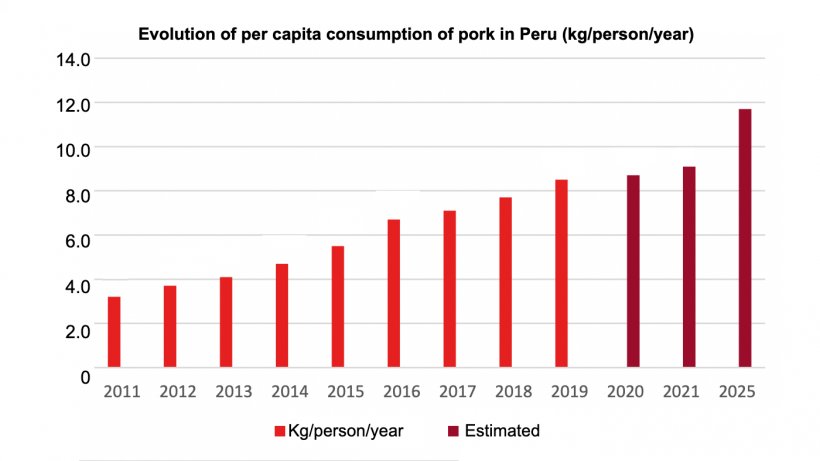Pork production and consumption are growing in Peru, which is why the new study, Peruvian Pork, Industry Analysis was conducted by The Trade Council of Denmark.
In 2019, Peruvian pork production reached a volume of 231,000 tons, a 5.0% increase compared to 2018's production (+47.1% from 2011). As of 2019, Peru represents 0.1% of global pork production. Although pork production and consumption in Peru is growing at a smaller scale compared to nearby countries, the country hopes to develop and grow the industry in order to be able to export to China. This may create opportunities for Danish companies or other countries.


According to calculations from the Peruvian Association of Pork Producers, there are 600,000 pork producers in Peru. Of these producers, 76% belong to the rural or self-consumption segment and produce about 48,000 tons of pork (20% of the annual production), the equivalent of 150,000 sows. Similarly, it is estimated that 12,000 tons of pork (5% of the annual production) are produced in semi-intensive breeding, the equivalent of 8,724 sows. Meanwhile, intensive breeding produces 180,000 tons (75% of the annual production), equivalent to 87,240 sows. It should be noted that 98% of mechanized pig farms are the result of the diversification of chicken-producing companies.
In 2019, per capita pork consumption in Peru reached 8.5 kg/year, 10.4% higher than the previous year. This represents a 165.6% increase compared to 2011, with sustained growth over recent years. The increase in consumption is directly related to the improvement of the Peruvian economy, in particular per capita income and the gastronomic boom in "Peruvian food."
The ranking of the most consumed meats in the country is led by chicken (51.0 kg/person/year), followed by pork (8.5 kg/person/year), beef (6.1 kg/person/year), turkey (1.3 kg/person/year), mutton (1.1 kg/person/year), and goat meat (0.2 kg/person/year). It should also be noted that the annual per capita consumption of milk is 87.0 kg, 17.4 kg for fish, and 2.5 kg for sausage. The following graph shows a growth trend estimating that pork consumption will reach 11.7 kilos by 2025.

When it comes to foreign trade, Peru does not export any pork, given that the country is not free of Classical Swine Fever (CSF). However, the Ministry of Agriculture and Irrigation (MINAGRI) is implementing a program to control and eradicate CSF in the main pork-producing regions, which will extend to 2023. This will help to improve national health and provide access to international markets, particularly in Asia. There were 137 CSF outbreaks in 2010 and 75 in 2019. It should be noted that the southern coast has had no outbreaks in recent years, which would allow pork from this region to be exported to Asia.
Imports have experienced an annual growth of 15.8% since 2013, when the country begn importing pork. There was a 107.8% growth in 2019 imports compared to 2013. However, in 2019, imports dropped 18.3% compared to 2018, particularly because Chile redirected its exports to the Chinese market, a market that has been reducing its domestic offer due to the negative impacts of the African Swine Fever (ASF) outbreak.
January 2, 2021/ The Trade Council/ Denmark.
https://thetradecouncil.dk/






